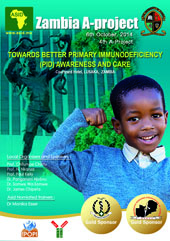Nesrine Radwan, Lecturer of Pediatrics, Children’s Hospital, Faculty of Medicine, Ain Shams University, Cairo, Egypt.
Leukocyte adhesion defect (LAD) is a rare, autosomal recessive primary immunodeficiency, in which there is defective phagocyte aggregation at the site of infection due to the absence of surface integrins. It is characterized by recurrent infections, non purulent abscesses, defective wound healing and marked leukococytosis. The main problem results from an impaired step in the inflammatory process, namely, the emigration of leukocytes from the blood vessels to sites of infection, which requires adhesion of leukocytes to the endothelium. So far, three types of LAD I,II, and III have been identified. The diagnosis is based primarily on flow cytometric analysis of neutrophils for the surface expression of CD11, CD18 and CD15s on leucocytes. Treatment options include antibiotics and bone marrow transplantation if suitable donor is available.
Case Presentation: We present a boy aged 13-years old, 7th in order of birth of consanguineous parents, who developed at the age of 20 months recurrent attacks of intermittent fever, multiple skin abscess which were cured with scar formation after long courses of antibiotic. He has normal developmental history and no history of delayed falling of umbilical stump. On examination he had average weight and height, positive BCG scar, no organomegaly or lymphadenopathy. His blood picture showed persistent leukocytosis TLC: 41X109/L, Hb;7.8gm/dl, Platelet: 420x109/L. Ig G:1450 mg/dl, IgM:227 mg/dl , IgA:243 mg/dl, IgE:29 IU/L. CD11b:12.9%(N:93%),CD18: 96% (N: 98%). Accordingly, the patient was diagnosed as LAD type-1. One month ago, he presented with severe abdominal pain, vomiting, fever and rigors. The metabolic profile and serum, amylase levels were within the normal range. High CRP (> 96 mg/L). The abdominal ultrasound (U/S) revealed evidence of acute cholecystitis. The patient received triple antibiotic therapy and the condition temporarily improved for few days after which he developed acute severe abdominal colic. Follow up U/S showed distended gall bladder with turbid fluid and air seen inside the gall bladder. Urgent open laparotomy was performed and revealed several cholecystogasrtic fistulae. Cholecystectomy and partial gastrectomy with gastric suturing in two layers was done. Wound dehiscence and disruption of all gastric sutures accompanied with secondary wound infection lead to deterioration of the condition. The patient now is receiving quadruple antibiotic therapy along with total parenteral nutrition (TPN) and leucocyte transfusion. So far, the condition is stable and there is poor surgical wound healing.
Reference:-
1-Amos EtzioniLeukocyte Adhesion Deficiency (LAD) Syndromes.2005. http://www.orpha.net/data/patho/GB/uk-LeucocyteAdhesionDeficiency.pdf
2- Tipu HN, TahirA,AhmedTA,Hazir T, Waqar MA. Leukocyte Adhesion Defect.J Pak Med Assoc, 2008;58 : 643-46.



























